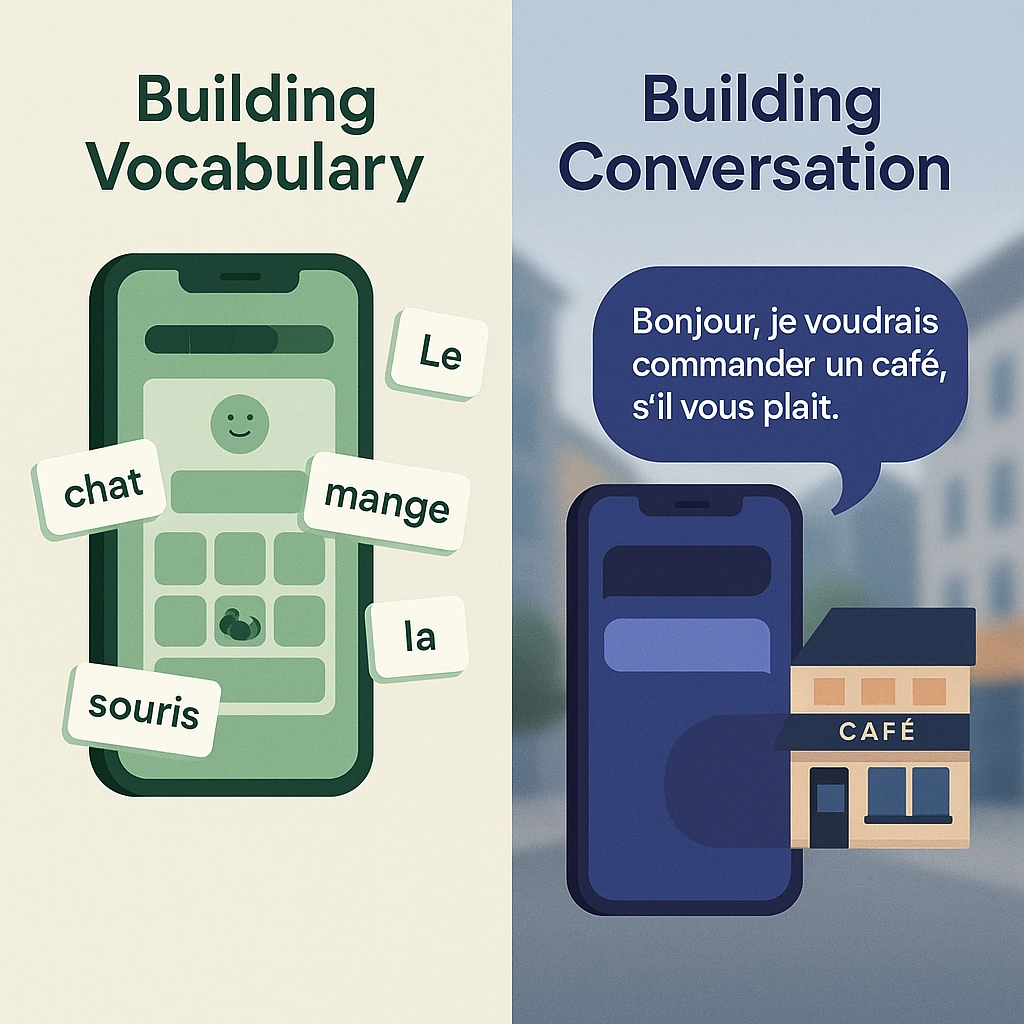If you’ve started learning a new language in the last decade, you’ve almost certainly met the little green owl. Duolingo has gamified language learning for millions, making it fun and accessible to build a foundation of vocabulary and grammar. It’s a fantastic starting point.
But then you hit the wall.
You know hundreds of words, but you can’t form a sentence in a real conversation. You can recognize a phrase, but you can’t produce one yourself without freezing up.
This is where the real challenge of language learning begins, and it’s where the purpose of your tools must change. The question isn’t “Is Duolingo a good app?” The question is, “Is Duolingo the right tool to make me a confident speaker?”
Let’s break down the two approaches and see which one is truly built to get the words out of your head and into a real-world conversation.
The Duolingo Approach: Building the Foundation
Duolingo is, at its core, a vocabulary and sentence-building machine. It excels at drilling words and simple phrases into your memory through repetition.
How Duolingo handles “speaking”:
- Repetition Exercises: You’re asked to repeat a specific, pre-written sentence into your microphone (e.g., “Le garçon mange une pomme“).
- Basic Word Recognition: The AI primarily checks if you said the correct words in the correct order.
Where it falls short for conversation:
- It’s Not a Conversation: You are simply repeating a static prompt. There is no back-and-forth, no unscripted response, no need to think on your feet. You are performing a task, not having a dialogue.
- Limited Feedback: The feedback is binary—either you got it right or wrong. It doesn’t tell you why your pronunciation was off, if your intonation sounded unnatural, or how your phrasing could be improved to sound more like a native.
- Lack of Real-World Context: The sentences are often random and decontextualized. While helpful for grammar, knowing how to say “The horse eats the purple bread” doesn’t prepare you for ordering a croissant in Paris.
The Verdict: Duolingo is like a master carpenter giving you a pile of perfectly crafted bricks (vocabulary). You have the materials, but you haven’t been taught how to build the house (have a conversation).
The Scenaria Approach: Building the House
Scenaria was built to solve the exact problem Duolingo leaves unanswered: How do you actually use the language you’re learning? It’s designed from the ground up to be a dedicated speaking partner.
How Scenaria handles speaking:
- Dynamic AI Dialogue: You aren’t repeating a script. You are having a genuine conversation with an AI partner that listens, adapts, and responds to what you say. If you ask a question, it answers. If you make a statement, it reacts.
- Granular, Real-Time Feedback: This is the game-changer. After you speak, Scenaria gives you a detailed breakdown:
- Pronunciation Score: See exactly which words you nailed and which need work.
- Grammar Corrections: Fixes your mistakes and shows you a more natural way to phrase your sentences.
- Flow & Intonation: Helps you move beyond robotic, word-for-word speech to sound more fluid and native.
- Real-World Scenarios: Instead of random sentences, you practice what you’ll actually need. From ordering coffee and navigating an airport to handling a job interview or negotiating a business deal, the context is always practical.
- Full Customization: Have a specific situation in mind? Describe it, and Scenaria’s AI will create a custom practice scene for you instantly.
The Verdict: Scenaria takes your pile of bricks from Duolingo and acts as your personal architect, teaching you how to put them together to build a strong, functional, and confident conversational ability.
Head-to-Head Comparison for Speaking
| Feature | Duolingo | Scenaria |
| Type of Practice | Repetition of pre-written sentences. | Dynamic, back-and-forth dialogue. |
| AI Partner | A voice that prompts you. | A partner that converses with you. |
| Pronunciation Feedback | Basic right/wrong on individual words. | Detailed scores and specific feedback on flow and accent. |
| Grammar Feedback | Marks sentences right or wrong. | Corrects your phrasing and suggests more native alternatives. |
| Real-World Context | Limited; often random sentences. | Core feature; library of practical, real-world scenarios. |
| Customization | None. | Fully customizable; create any scene you want. |
| Best For | Building vocabulary and basic grammar. | Building conversational confidence and fluency. |
Conclusion: The Right Tool for the Right Job
Duolingo is an excellent tool for starting your journey. It’s the best free app for getting your foot in the door and building a base of words.
But when your goal shifts from knowing words to using them, you need a specialized tool. You wouldn’t use a hammer to saw wood. Likewise, you shouldn’t rely on a vocabulary app to master conversation.
Use Duolingo to build your vocabulary. Use Scenaria to learn how to speak.
If you’re tired of feeling like you know a language but can’t speak it, the choice is clear. It’s time to move from flashcards to fluency.

